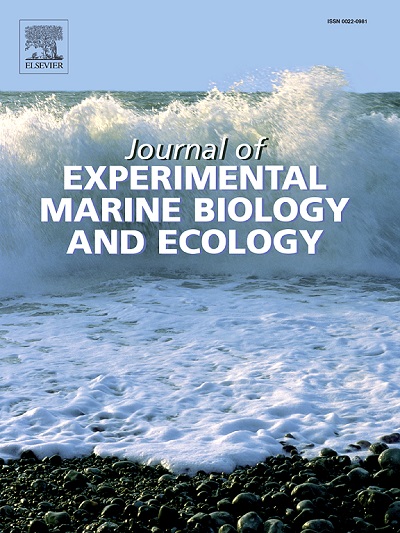Fine-scale spatial and temporal dynamics of subtidal reef fish assemblages and implications for monitoring
IF 1.8
3区 生物学
Q3 ECOLOGY
Journal of Experimental Marine Biology and Ecology
Pub Date : 2025-04-15
DOI:10.1016/j.jembe.2025.152102
引用次数: 0
Abstract
Fine-scale spatial (i.e. less than one hectare) and temporal (i.e. less than one week) dynamics of reef fish assemblages are often not properly accounted for in sampling designs, impeding the proper assessment of the effects of broad-scale processes such as climate change and anthropogenic pollution. The aim of this study is to identify and quantify the fine-scale spatial and temporal drivers of variability of subtidal reef fish assemblage structure. On the island of Santa Cruz (Galapagos, Ecuador), video transects were used to assess daily, diel and spatial trends in the structure of the observed fish assemblages and environmental measurements were taken to evaluate the effect of water conditions and physical habitat characteristics. Biological variability was explained by physical habitat characteristics, spatial auto-correlation, daily variability and water conditions. There was no significant diel variability although most water conditions showed clear diel rather than daily trends, suggesting that the prevailing water conditions were not important at the studied scale. Fine-scale spatial variability in combination with daily fluctuations of the structure of reef fish assemblages are likely linked to food availability and fish movement. Studies aiming to understand broad-scale processes, while accounting for fine-scale variability, typically rely on labor intensive power and sample size estimations to guide the distribution of sampling effort. However, we show that fine-scale variability can be attributed up to 42 % to spatial, temporal and environmental drivers, thereby indicating that ecological knowledge can be used to select the most appropriate sampling design. Accounting for habitat characteristics and sampling variability, through multiple transects and repetitions respectively, proved most important in the study of reef fish assemblages of the Galapagos.
潮下礁鱼群落的精细尺度时空动态及其监测意义
在采样设计中,往往没有适当考虑到细尺度空间(即小于一公顷)和时间(即小于一周)的珊瑚鱼组合动态,从而妨碍了对气候变化和人为污染等大尺度过程影响的适当评估。本研究的目的是识别和量化潮下礁鱼组合结构变化的精细尺度时空驱动因素。在圣克鲁斯岛(厄瓜多尔加拉帕戈斯群岛),利用视频样带评估观察到的鱼类组合结构的日、日和空间趋势,并采取环境测量来评估水条件和自然生境特征的影响。生物变异由生境物理特征、空间自相关、日变异和水分条件解释。尽管大多数水条件显示出明显的日变化趋势,而不是日变化趋势,但没有显著的日变化,这表明在研究尺度上,主要的水条件并不重要。细尺度空间变异性与珊瑚鱼组合结构的每日波动相结合,可能与食物供应和鱼类运动有关。研究旨在了解大尺度过程,同时考虑精细尺度的可变性,通常依赖于劳动密集型功率和样本量估计来指导抽样努力的分布。然而,我们表明,精细尺度的变异可以归因于高达42%的空间、时间和环境驱动因素,从而表明生态学知识可以用来选择最合适的采样设计。在加拉帕戈斯群岛珊瑚鱼群的研究中,分别通过多次样带和重复取样来考虑生境特征和采样变异性是最重要的。
本文章由计算机程序翻译,如有差异,请以英文原文为准。
求助全文
约1分钟内获得全文
求助全文
来源期刊
CiteScore
4.30
自引率
0.00%
发文量
98
审稿时长
14 weeks
期刊介绍:
The Journal of Experimental Marine Biology and Ecology provides a forum for experimental ecological research on marine organisms in relation to their environment. Topic areas include studies that focus on biochemistry, physiology, behavior, genetics, and ecological theory. The main emphasis of the Journal lies in hypothesis driven experimental work, both from the laboratory and the field. Natural experiments or descriptive studies that elucidate fundamental ecological processes are welcome. Submissions should have a broad ecological framework beyond the specific study organism or geographic region.
Short communications that highlight emerging issues and exciting discoveries within five printed pages will receive a rapid turnaround. Papers describing important new analytical, computational, experimental and theoretical techniques and methods are encouraged and will be highlighted as Methodological Advances. We welcome proposals for Review Papers synthesizing a specific field within marine ecology. Finally, the journal aims to publish Special Issues at regular intervals synthesizing a particular field of marine science. All printed papers undergo a peer review process before being accepted and will receive a first decision within three months.

 求助内容:
求助内容: 应助结果提醒方式:
应助结果提醒方式:


